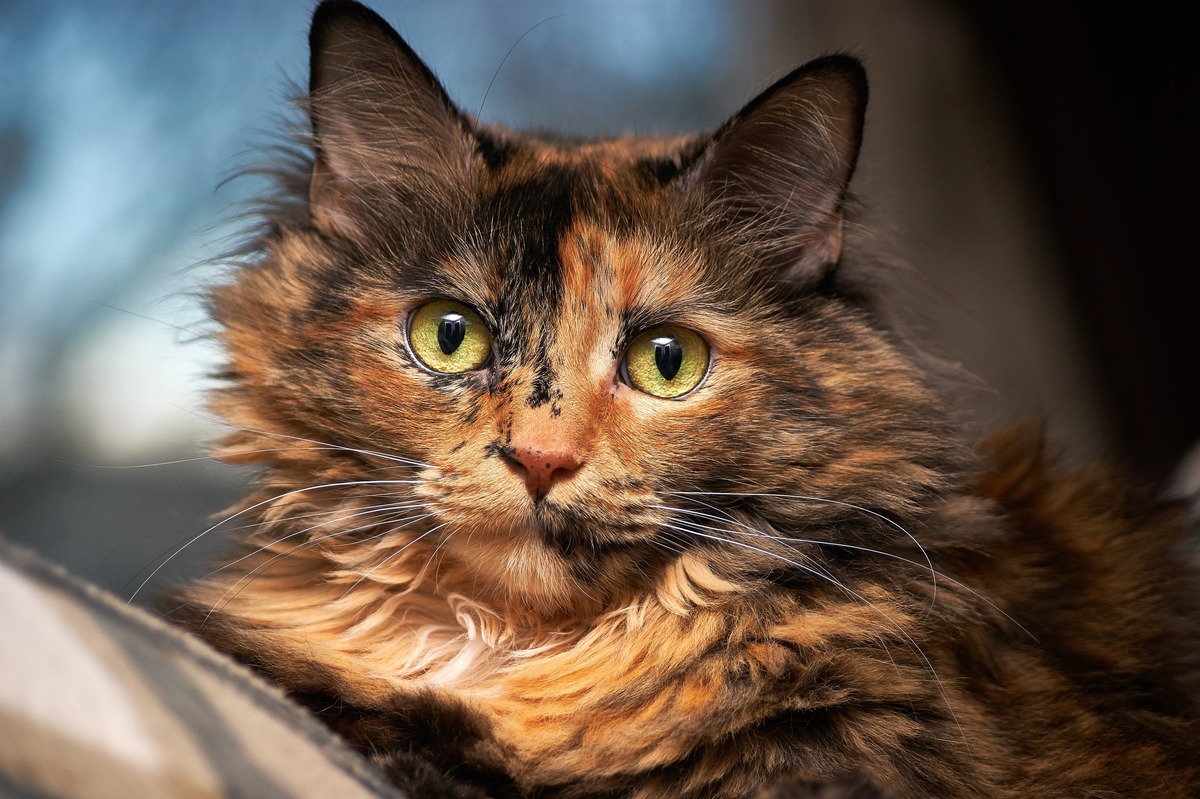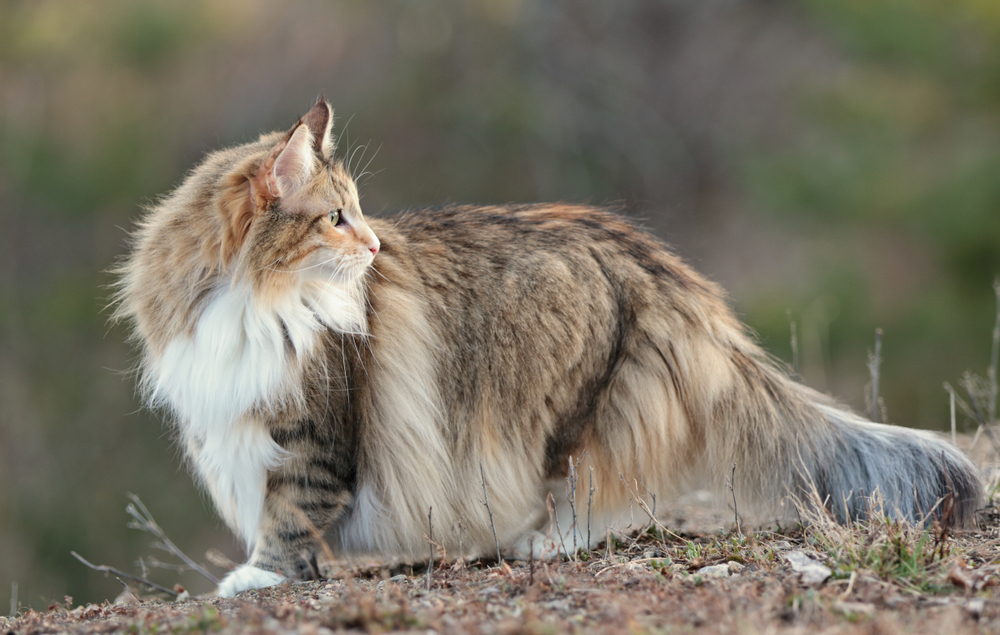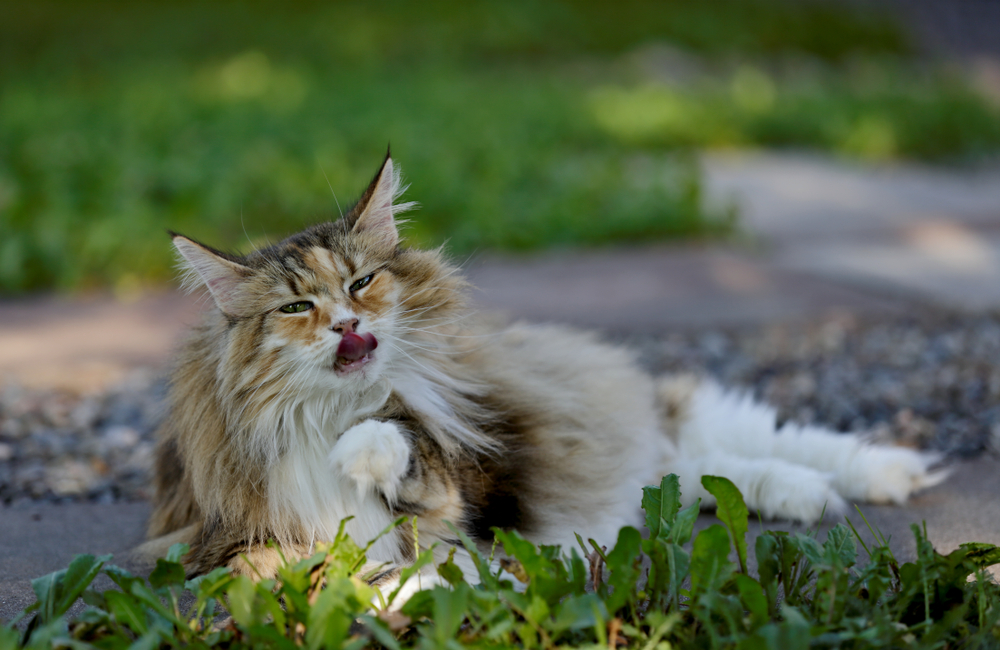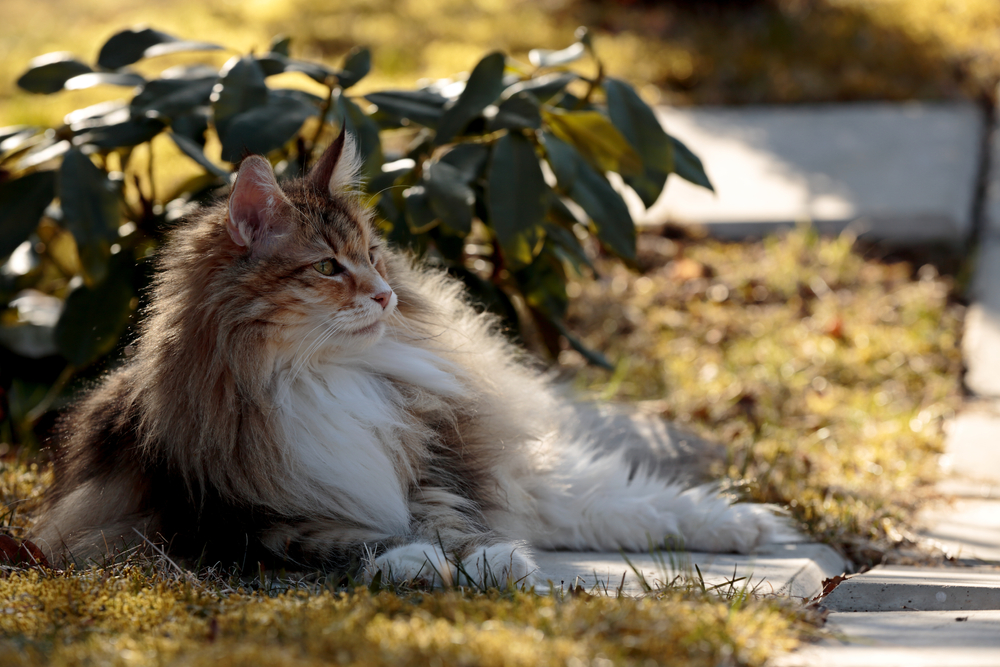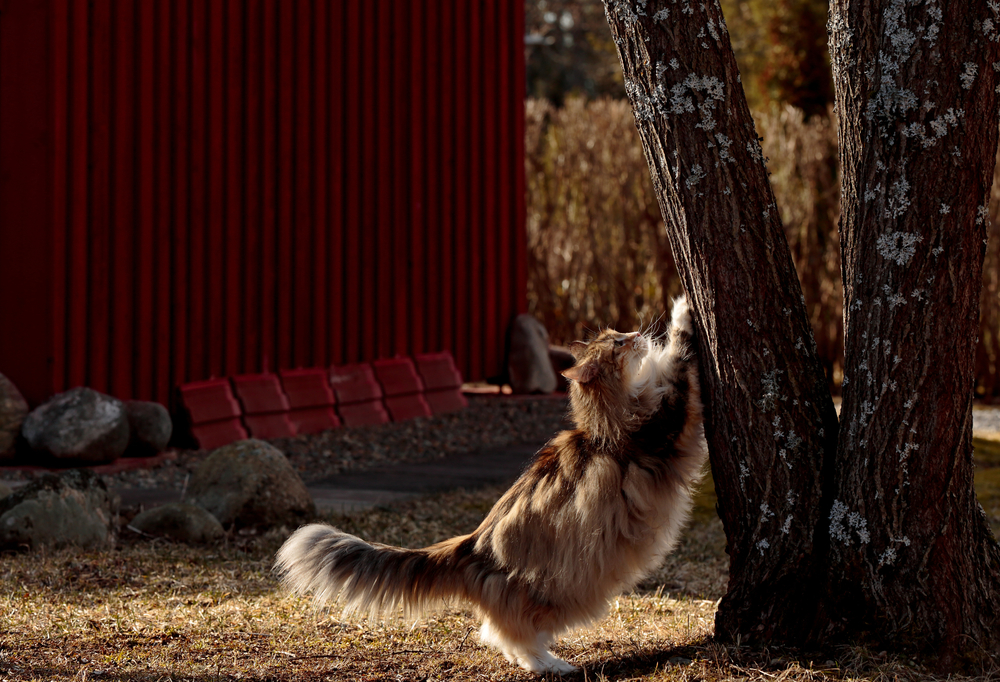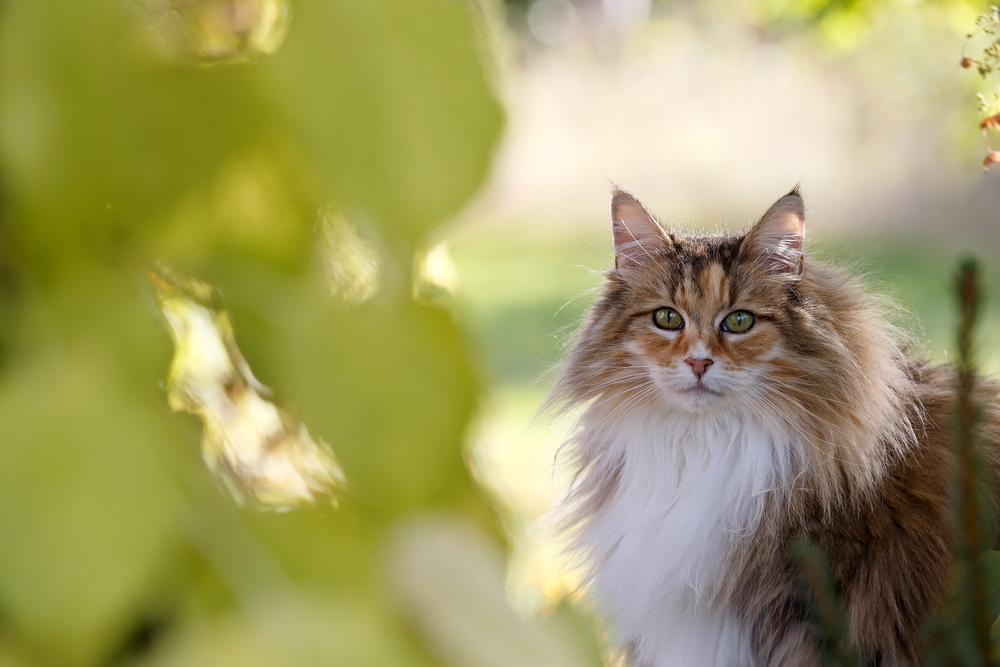📖 Table of Content:
Norwegian Forest cats are one of the most affectionate, appreciative breeds out there. Wegies are large, lovable cats with strong, sturdy bodies and long, luscious coats. We’d argue that Wegies are everyone’s cup of tea, but tortoiseshell Norwegian Forest cats take the cake.
Tortoiseshell Norwegian Forest cats are beautiful creatures affectionately called “torties.” Torties are named after tortoises because they’re embellished with a unique, multicolored fur that resembles the shell of a tortoise. Deemed “the divas of the cat world,” torties are sought-after for a reason.
Now, we don’t know whether the color of a cat’s coat affects the cat’s personality. We know that black cats are often rumored to bring bad luck or that orange cats act unhinged and unpredictable. Pet parents of tortoiseshell Wegies, however, swear that they’re different from cats of other colors.
Norwegian Forest cats can assume pretty much every color of the rainbow, too. White, black, blue, red, cream, silver, and golden are the most common colors with solid, shaded, tortoiseshell, calico, and tabby patterns. Tortoiseshell Wegies aren’t rare, but you might struggle to get your hands on one anyway.
What are tortoiseshell Norwegian Forest cats? What’s the history of them? What to expect when you get a tortoiseshell Norwegian Forest cat? We’re bringing you all that and more down below!
What are tortoiseshell Norwegian Forest cats?
Norwegian Forest cats are oftentimes compared to Maine Coons because they’re large, lovable animals with plenty of fur to spare. Wegies are popular across the world, but they’re favorites in their native land of Norway, where they go by the name “skogkatt.” Where do we even start with them?
We know that they’re big, but you may be surprised to know that an average Wegie grows 9 to 12 inches tall and weighs 12 to 16 pounds. Wegies make for the perfect pets, whether that’s because you can cuddle them for hours or because they’re more than happy to play with you even when they’re tired.
What’s the tea with tortoiseshell Norwegian Forest cats, though? Wegies are defined by the layers and layers of fluff they’re blessed with and that’s what sets torties apart from other Wegies. Tortie Wegies, as the name suggests, are felines with coats resembling the particolored shell of a tortoise.
Torties are typically white with red, cream, and black tipping around the strategic areas of the body. What makes tortie Wegies even better happens to be the fact that they’re almost always female. When you’re on the hunt for a male tortie Wegie, you might need to bite the bullet and go for a different color or pattern.
Whatever the case may be, tortoiseshell Norwegian Forest cats are one of the most beautiful, bold breeds you’re ever going to meet – and they’re more than deserving of getting spoiled rotten.
What’s the history of the tortoiseshell Norwegian Forest cat?
We might as well go back to the beginning of time, right? We don’t know whether the first Norwegian Forest cats were tortoiseshell, solid, or calico, but we do know that they played a huge part in Norwegian history. Whether they were born there or brought there by a third party, that’s a mystery.
Norwegian myths and tales galore mention a large, long-haired cat with the ability to climb rock faces and stones that other cats could not manage. We’re pretty sure that these myths and tales were talking about Wegies, but we don’t have definitive proof of that.
We’ve got theories aplenty, though.
A theory suggests that Wegies might have been related to black-and-white, short-haired cats from Great Britain that were found on Viking ships at the time. Another theory contradicts that by suggesting that they might have been descendants of long-haired cats brought to Scandinavia by the Crusaders.
And we can’t forget about the theory that makes the most sense – Wegies might have been roaming around the Norwegian forests thousands and thousands of years ago where they evolved into the large, dense-coated animal we know and love today. Tortoiseshell or not, Wegies were (and are) a mystery.
What to expect when you get a tortoiseshell Norwegian Forest cat?
Physical traits of the tortoiseshell Wegie
Norwegian Forest cats, tortoiseshells or otherwise, are large, loving cats though they don’t usually like laying in anyone’s lap.
We know we talked your ears off about tortoiseshell Wegies’ coats, but that’s one of the most spectacular features that come with these bad boys. When you think of a tortoiseshell Norwegian Forest cat, chances are you think of a giant ball of fluff strutting her way on fluffy paws. Why are Wegies fluffy, though?
We mentioned beforehand that Wegies share some sort of a connection with Norwegian forests (hence the name), and that might be the reason why they’re embellished with multiple layers of fur. Norwegian winters are harsh and Wegies needed to evolve in such a way to survive the snowstorms.
With time, they managed to develop extra layers of fur that protected them from the cold and the wet. A Norwegian Forest cat’s coat consists of a longer, coarse, and water-resistant outer coat that embellishes the cat and a short, dense undercoat that provides warmth.
A closer look at a Wegie cat will reveal a ruff at the chest, a collar at the neck, and a bushy tail, too. And that’s why Norwegian Forest cats require regular grooming and brushing – whether we’re talking about the shedding season or not, your Wegie will shed A LOT.
Personality traits of the tortoiseshell Wegie
Wegies are curious creatures. Whether you’re planning on getting a tortoiseshell Wegie kitten or you’re already running around the apartment after one, you might be wondering whether they’re ever going to grow up. Wegies are known to mature slower which means you get to enjoy the kittenish phase for years.
Norwegian Forest cats, regardless of the color of their coats, are affectionate, appreciative felines that adore hanging out with humans. Gorgeous and gentle, they’re more than happy to spend time with you and your friends without getting bored. Wegies are laid-back and prefer when you come to them.
We know some pet parents are obsessed with cats that meow all the time (a.k.a. Maine Coons), but Wegies are far from Chatty Cathys. Wegies are a quiet breed and that’s something that happens regardless of the color of their coat. Extremely family-oriented, they’re guaranteed to enrich your life.
4 fun facts about tortoiseshell Norwegian Forest cats
1. Wegies are mythical creatures
We’re not kidding! According to Norse mythology, Norwegian Forest cats belonged to Freya, the Norse goddess of love and beauty. Freya adored her cats more than humans and that’s why humans often used cats as a way to get Freya to help them with something.
And we can’t forget about another god who was connected to Norwegian Forest cats. Apparently, Thor, the god of thunder, underwent a contest of strength against a god by the name of Jormungand. Thor didn’t win the battle solely because Jormungand was disguised as a Norwegian Forest cat.
We don’t know whether these Wegies were tortoiseshells or not, but we do know that these curious creatures deserve our time of the day considering what they’ve been through.
2. Norwegian Forest cats nearly became extinct
Nowadays, Wegies are adored by pretty much everyone, but that wasn’t always the case. When Wegies started popping up for the first time, they were cared for by farmers and sailors because they were great at catching mice and protecting people from disease. But the cat fanciers didn’t care about them.
Breeders typically used them to create other breeds and that’s when things went south. During World War II, Norwegian Forest cats faced extinction because the breeders didn’t care enough to protect them from going extinct. An official breeding program preserved the breed’s lineage for future generations, though.
3. Tortoiseshell cats are known to possess “tortitude”
Tortoiseshell Norwegian Forest cats are little divas, to say the least. We can’t claim that there’s a connection between the color of a cat’s coat and the attitude she ends up with, but there’s a reason torties’ alleged “tortitude” always comes up.
Pet parents of tortie cats swear that they’re strong-willed, stubborn, and fiercely independent.
Wegies are already known to be incredibly independent which means that a tortie Wegie might get bored of your advances pretty quickly. We’re kidding, we’re kidding. We’re pretty sure that “tortitude” simply means that a tortie Wegie won’t take no for an answer.
4. Torties are almost always female
We’ve arrived at the end of the article with a fun fact that makes us appreciate girl power even more. We weren’t making a fool out of you when we said that tortoiseshell Norwegian Forest cats are almost always female.
It all boils down to genetics – the female chromosome X carries the gene for both orange and black coat colors. What does that mean? With two X chromosomes, females can be born with both orange and black coloring. Males can’t be both orange and black, which means male tortoiseshell cats are super, super rare.
